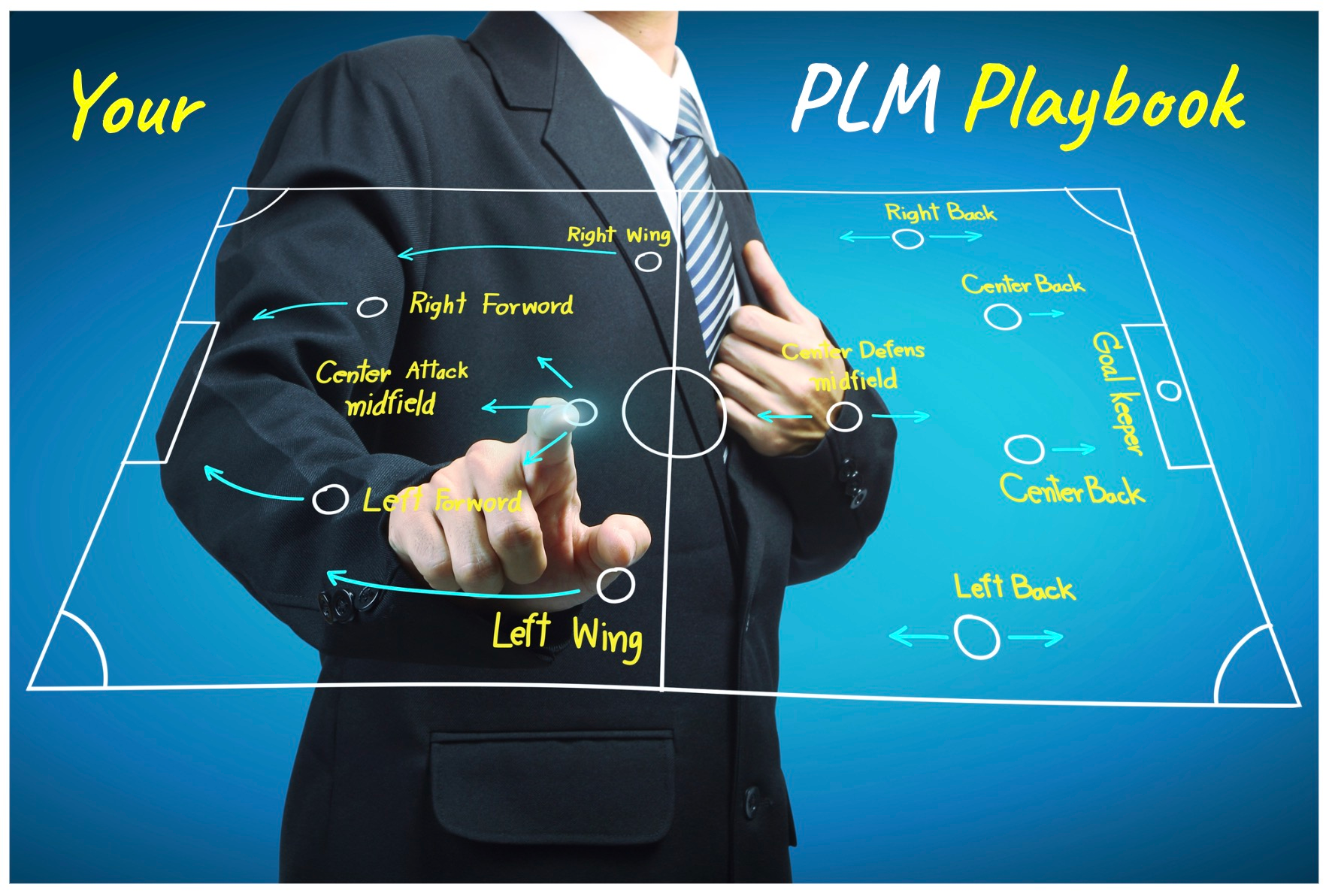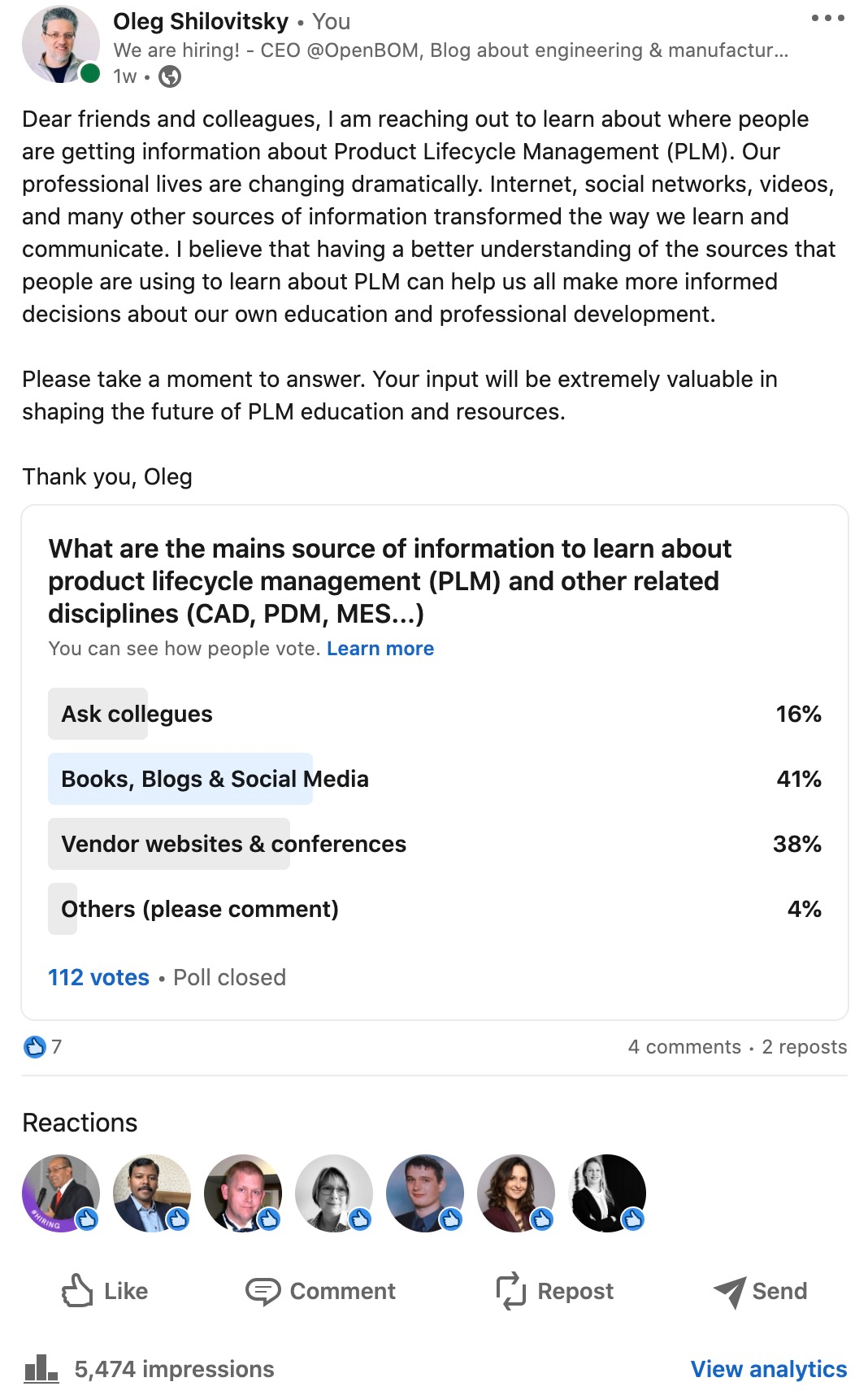
Learning is hard. The world around us is changing and the same is happening with the process of learning. The Internet changed the way we can get information and learn, opening up many new ways to communicate and capture information and knowledge. Getting back 20+ years ago, I remember how I had to order the EAI-649 Configuration Management handbook printed on paper and sent the package to me using UPS or FedEx. Not anymore. Now I can get it by Googling and downloading it (even if sometimes I need to put in my credit card and pay it before).
Learning Product Lifecycle Management (PLM) is essential for any modern manufacturing industry and those who want to stay competitive. It’s no surprise that implementing a PLM system into current strategies can bring immense value – for the last two decades, PLM technology has been traditionally used to streamline the product design process, tracking them through production, lifecycle management, and finally digital archiving purposes. The challenge comes in learning which specific tools are necessary for running an effective PLM strategy for your unique business processes.
In this article, we will explore options to learn PLM and how to start developing a robust PLM plan tailored to your company’s needs and resources.
Enterprise Software and PLM systems
Enterprise software is a complex and rapidly evolving field that requires a significant investment in time and resources to master. The technical aspects of these software systems can be challenging, as they often involve integrating multiple systems, dealing with large amounts of data, and adapting to changing business requirements. In addition, the skills required to effectively use and manage these systems are constantly evolving, making it difficult for individuals to stay current and competitive. Despite these difficulties, learning enterprise software is a critical component of success in many industries, as it allows organizations to streamline operations, improve decision-making, and enhance overall efficiency. Therefore, if you’re committing to stay up to speed in enterprise software, you need to find a robust mechanical system that will allow you to continuously invest in education and professional development.
Product Lifecycle Management (PLM) involves a range of processes and technologies that help organizations streamline the product development process, improve collaboration, and enhance decision-making. Learning PLM can be overwhelming, especially for beginners who are unfamiliar with the concepts and terminology. Talking to many people in manufacturing organizations, I found that gaps in education and skills often prevent people from setting the right program and investing in PLM and related digital transformation programs.
How To Learn PLM LinkedIn Poll
About a week ago, I posted a poll on my LinkedIn asking my colleagues and professional connections to share their experience in learning about PLM. The simple question I asked was about their preferences for learning. Here is the question and results of the poll.

I found the results interesting. On one hand, the results confirmed that modern methods of getting information online are leading from a popularity standpoint as a source of information about PLM practices. On the other hand, I was surprised by a very low percentage of people selecting the “ask a colleague” option. It was especially interesting because, in our everyday life, we increasingly rely on peers, friends, and public reviews. But, the high number of votes for blogs, books, and social media, motivated me to think about how to improve Beyond PLM articles and provide additional information helping every PLM professional to learn more about PLM.
The PLM Playbook
In this article, I’m starting a series of blogs about how to develop a system and the process that can help every IT and PLM professional to come up to speed with Product lifecycle management knowledge and develop a plan for how to improve PLM practices for their team, company, or even individual work.
It will help you to learn PLM, covering everything from the basics to the advanced concepts and tools. Whether you’re a product manager, engineer, designer, or anyone else looking to gain a deeper understanding of PLM, this blog will provide you with all the information and resources you need to get started.
I will cover your way to PLM. We’ll begin discussing by defining what PLM is (yeah… you need it too sometimes), explaining its key components and benefits (especially when you need to explain PLM to your boss… kind of “explain to child way”), and providing an overview of the different stages of the product lifecycle (this is your future PLM journey). From there, we’ll dive into the different PLM tools and technologies available, as well as the skills you’ll need to develop to become a successful PLM professional. We ended up with a practical guide to implementing and optimizing your product lifecycle management system and practices (It will become your PLM playbook). We will cover multiple disciplines of product lifecycle management (PLM) starting from product data management (PDM), and supply chain management, and cover a full product lifecycle. We discuss product data and computer-aided design (CAD). We will talk about data quality and how to choose the right PLM solution for your company. We will touch, of course, your business strategy and product value chain. It will take some time, so, buckle up and get ready to embark on a journey to mastering PLM!
Where To Learn About PLM?
Let’s start with the obvious today and talk about the main sources of information. In the modern world, GTS (Google This Sh-t) technique is becoming a first step in everything. The recent appearance of Generative AI (Chat GPT) created an exciting alternative to obtaining knowledge. However, in both situations, knowing what to search (or ask) for is absolutely important (also, what to do with the results of the search and how to apply it to your case, but we will talk about it in the next articles)
Here are my top 5 sources of information to start with your PLM learning:
- Online tutorials and video courses: Start with online tutorials and courses. Websites like Udemy, Coursera, and YouTube offer a variety of tutorials and video courses that cover a range of software applications. These resources are created by experts and practitioners. Check my article – How to find the best blogs, books, and other resources about PLM. My absolute favorite is SharePLM Free PLM course(you have to give up your junk email address to get it)
- Official documentation and help resources: PLM solutions and vendors usually provide information. These days, vendors make most of the information available online. Sometimes, the most comprehensive tools are not available for public access, but I found the trend towards publishing more and more information and tutorials online. For example, OpenBOM Training Library (disclose -I”m CEO and c0-founder). Community forums are also a good source of knowledge. These resources can include user manuals, FAQs, and forums where you can ask questions and get answers from other users.
- In-person training and workshops: Analytical companies and vendors are also offering training workshops and educational programs. Check a few examples such as CIMdata Education or Institue of Process Excellence. PLM software vendors offer in-person training courses and workshops. Some of them are aligned with vendor conferences, but some others can be tailored directly to customers.
- Practice and experimentation (especially with SaaS PLM software): The best way to learn any software is to dive in and start using it. Until very recently it was not so simple for PLM tools that require an extensive setup, configuration, and tuning. However, the recent expansion of SaaS PLM tools changed that status quo. Nowadays you can take a quick registration and use a trial period to learn and experiment. Not all vendors provide it without special commitment, but here are a few examples – OpenBOM Trial, and Siemens PLM TeamcenterX. Try experimenting with different features and functions to get a feel for the software’s capabilities. If you encounter any problems or challenges, look to online resources or reach out to a user community for help.
- Collaboration with experienced users: Talking to people can make a real difference. Reading and listening to the course is important, but cannot replace live communication and experience sharing. This is where you need a real PLM adviser. Working with others who have experience using the software can be a great way to learn. You can observe how they use the software, ask questions, and learn from their experiences.
What is my conclusion?
There is no single, simple, and easy way to PLM. The good news is that I’m here to help you. I started this blog 15 years ago to share PLM knowledge because I’ve seen a huge knowledge gap in this field. We are in much better shape now. PLM is recognized as a system of business practices and technologies to help manufacturing companies.
Here is my 2023 resolution (I know, I’m a bit late and it is February). I want to help you to learn everything you need to know about Product Lifecycle Management (PLM). We’ll start with the basics of PLM, including what it is, its key components and benefits, and the different stages of the product lifecycle. Next, we’ll explore the different PLM tools and technologies available and the skills required to be a successful PLM professional. Finally, we’ll provide a practical guide to implementing and optimizing your PLM system, complete with a PLM playbook to help you master the process. Get ready for a comprehensive journey to PLM success with Beyond PLM. And I’m not doing it alone, but… wait for a surprise later.
Regardless of the approach you choose, the key to learning engineering and manufacturing software is to be persistent and don’t stop. PLM is all about technology and people. While technology is easy, people can be really hard. I’ve heard this sentence many years ago, but I keep repeating it. With time and effort, you can become an expert in PLM software and how to help people to make PLM happen. You will learn how to use it to enhance your engineering and manufacturing processes.
Just my thoughts…
Best, Oleg
Disclaimer: I’m co-founder and CEO of OpenBOM developing a digital cloud-native PDM & PLM platform that manages product data and connects manufacturers, construction companies, and their supply chain networks. My opinion can be unintentionally biased.












